50 Actionable SEO Tips for Vacation Rentals
Position your vacation rental website on the first page of Google with our 50 actionable hacks to improve your website's SEO.
Introduction
Search engine optimization is an increasingly talked-about topic in the vacation rental industry. With so much competition – from listing sites and competitors alike – the average vacation rental website doesn’t have much chance at succeeding without SEO.
And in order to really get your vacation rental website dominating Google search results, you’re going to need good SEO.
We know how easy it can be to get lost in the internet’s many millions of articles about search engine optimization. But SEO doesn’t have to be a scary or strenuous task.
In this eBook, you’ll find 50 actionable tips that you can start implementing right away for your vacation rental website. As we’ve split this guide into handy sections for on-page; keyword research; off-page; images and content – you can easily skip to the topic you need help with most.
What’s really important to remember is that SEO is a long process. It requires time and patience in order to see real results. But they will come eventually! You don’t need to put all these tips into practice in one day, but the more you take SEO into consideration when you are performing updates to your website, the better chance you have at ranking and being seen by the right guests.
Let’s get started and take a look at the 50 things you can do to improve your website’s SEO!
On-page SEO
1. Decide on a branded domain name over a keyword-stuffed one
One of the first things you’ll need to do when you set up your business and website is deciding on your property name, and therefore, domain name. In the majority of cases, it’s better to choose a domain that’s branded over one that just stuffs a load of keywords into it. Partially matching branding with the destination can work really well for many vacation rental owners.
Here are some examples:
- lighthouseNJ.com
- sweetbeachvacations.com
- sandcastleorlando.com
2. Use an appropriate domain extension
Top-level domains (TLDs), such as the “.com” extension, tend to give the best results for all kinds of businesses. However, if it’s likely you’ll only attract guests from your home country, you might want to think about using country-specific ccTLDs.
For example:
- .co.uk
- .fr
- .es
- .au
- .de
- .it
3. Keep your domain short and sweet
Not only is a long domain a mouthful to say, but it makes it more difficult to type and more prone to errors. Plus, a short domain just looks better. A short, punchy domain name will also be much easier to spell out over the phone and will fit neatly onto a business card – it’s a win, win situation!
4. Use your top keyword in your title tags
One of the strongest on-page signals your website can send to search engines is when you have your main keyword in its titles. That’s why you should ensure every page of your website has a unique title tag with one (just one, not two or three, one) mention of your keyword – preferably at the beginning.
5. Optimize titles so they don’t truncate
Google has a way of truncating titles that are too long – or rather, that do not fit into its 600-pixel frame. That’s why SEO specialists recommend keeping titles between 50-60 characters for optimum results.


However, it’s not that simple. As some characters occupy more space than others (e.g. capital letters and wide letters such as ‘M’, ‘W’ and ‘N’), you may need to rework your website titles to make them fit without truncation. Check out the Moz guide to writing title tags for more details.
6. Optimize titles for click-throughs
More clicks can also help you move up the rankings, so make sure that your headlines are attractive enough to make users click. Not only can you do this for all your website pages (such as ‘about us’, ‘about the area’, ‘press’ etc.), but you can also easily optimize on your vacation rental blog – as you’ll have more room to play around with fun titles!
Once you have a library of posts and data, you can run tests depending on which were the most successful – and devise new titles from these results.
7. Include your brand name and a tagline in your homepage title tags
The most important area of your website – your homepage – needs to be the most optimized when it comes to title tags. It’s often recommended to have your brand mention first, then a strapline.
Check out Airbnb as an example:

8. Don’t worry about including your brand name in other page title tags
Besides from on your homepage, it’s not necessary to include your brand name in your other website page title tags, because Google often adds this automatically. Great news because you’ll be able to use your limited characters more wisely!
9. Try not to waste space in page titles
Not only can you save a few characters by omitting your brand name from every title, but also by cutting out stop or connecting words, you’ll have a more optimized title.
Words we’re talking about are: a, and, is, on, of, the, was, with… etc.
10. Take advantage of ‘purchase intent’ keywords
You’re a vacation rental owner or property manager, so your main goal is to achieve bookings for your home. As guests may already be searching for rentals in your area, you can grab their attention from the outset.

Adding a “Book” in front of your titles – e.g. “Book Florida vacation rentals online” – will help capture those guests who are already in the right stage of the buyer’s journey.
11. Use keywords in your meta descriptions
Keywords in meta descriptions no longer have an effect on ranking. However, they do show up in bold in search results, which can, in fact, encourage a higher click-through rate.

12. Optimize meta descriptions so they don’t truncate
Just like website titles, meta descriptions also truncate after a certain number of characters. This is also based on pixels, but generally, meta descriptions under 155 characters (maximum) should help minimize the possibility of truncation.

13. Add a unique H1 tag for each page on your website
The header text, or H1, is one of the most important on-page SEO features. Make sure your keywords appear in your page’s H1 and that there is only one H1 per page.
You can use a free tool such as the Chrome extension SEO Meta in 1 Click to check what others (or even your competitors) are using as their H1 tag.

14. Use other keywords in H2s and H3s
You can target other keywords which are not as important as your main keywords in other headers throughout your page – particularly if you are adding to your vacation rental blog. You can also use LSI (latent semantic indexing) keywords (those which are related to your main search terms) in H2s and H3s to improve your chances of ranking better.
15. Use short, descriptive URLs
Short URLs not only look better but when they have your keyword in, they can also help you rank higher.

16. Keep your contact information on display
If you’re planning to run your vacation rental via your website, people are going to need to contact you!
Hiding your contact details from Google is a big no-go when it comes to SEO. So get more inquiries and have Google trust you when you have clear, easy-to-find contact details on your website.
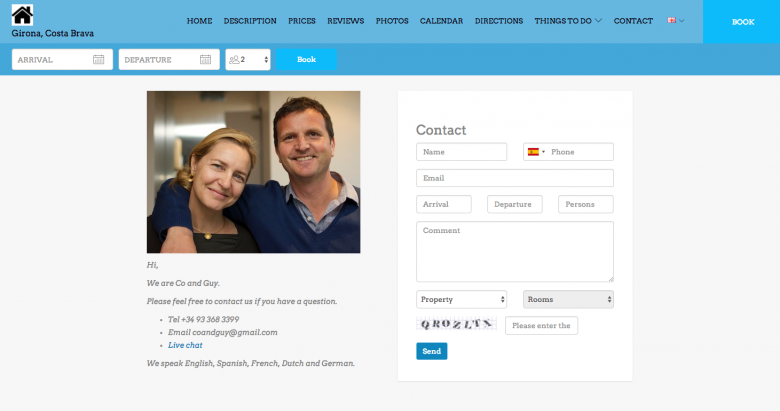
17. NAP at all times
Sadly, we’re not advising you to take a siesta constantly.
Instead, we’re reminding you to include your business Name, Address and Phone number on all the pages of your website, preferably in the footer.
This is important for targeting local search as you’re emphasizing your location to Google and sending out good trust signals.
18. Test your website load time
Many guests will abandon a vacation rental website if it doesn’t load quickly enough, so check how your website is doing with a free tool like Pingdom or Google PageSpeed Insights.
19. Follow recommendations for optimizing load time
If Google PageSpeed Insights comes back with a low score, do all you can to get your numbers up. While 100% might not be completely achievable without professional help, fix the things you can on your own to improve loading time for SEO.
Keyword Research
20. Always conduct keyword research before you write a blog post
The whole point of starting a blog for your vacation rental is to gain traffic – right? So make it as relevant as possible by researching keywords before you even generate blog post ideas.
Use a tool like Google Adwords Keyword Planner to find search volumes and new keywords for your business and upcoming blog posts. Check out this Google help centre article for basic tips for building a keyword list.
21. If your website is new, target low competition keywords to rank more quickly
New websites are more difficult to rank for competitive keywords, but there is a way to get your site noticed more quickly.
Just target certain keywords that have a lower difficulty and therefore lower competition than the top keywords. You can use a free tool like Google Keyword Planner to help determine which keywords you should try to rank for.
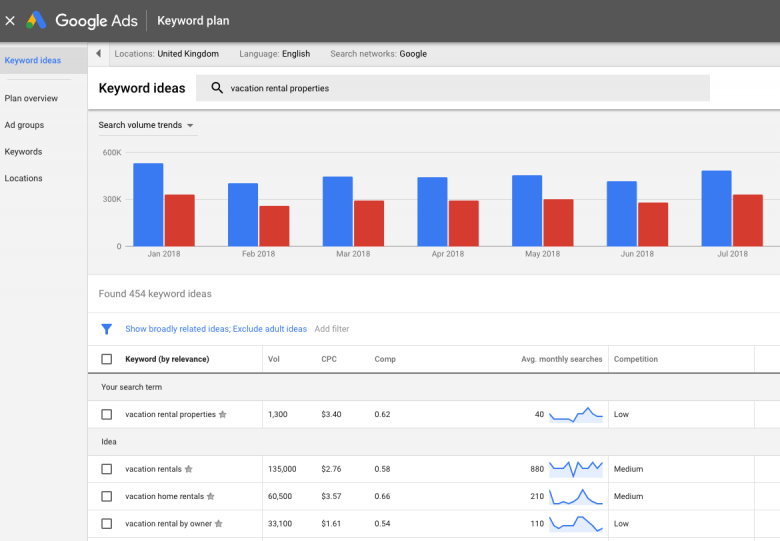
22. Identify your competitors’ keywords, and use them yourself!
As the vacation rental industry is becoming increasingly competitive with more and more rentals popping up all the time, owners and managers have to get creative.
By identifying your competitors’ keywords and the amount of traffic they bring, you can aim to target these yourself to drive more traffic your way.
23. Rank for similar keywords by grouping them
Google is extremely smart and can identify relationships between keywords and other similar ones. Because of this, it’s now possible to rank for multiple keywords with just one page or blog post! So start by choosing one main keyword, then building groups of keywords that are very closely linked with this one to integrate into your website content.
24. Use Google “People also ask” to find other keywords to target
Often, when you carry out a Google search, Google will provide you with other frequently searched terms in the “People also ask” box. (Note: sometimes this appears at the top of search results, and other times it’s a bit further down). These related searches may help you find new topics to write about that other vacation rental guests are already searching for.
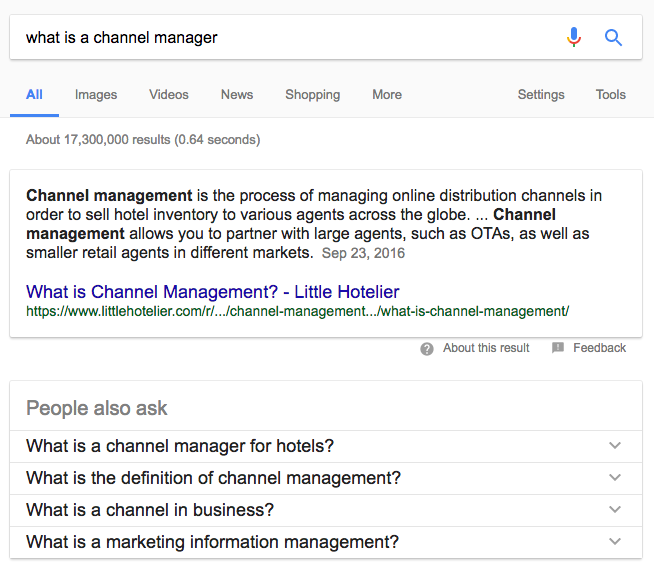
25. Make the most of Google autocomplete to find new keyword ideas
Simply type your original keyword idea into Google, and as if by magic, autocomplete will provide you with a list of suggestions.

It’s not magic at all, really. In fact, these are usually the most searched terms that start with the same phrase you entered. And can also provide you with more ideas for your content.
26. Delete words from Google autocomplete for even MORE keyword ideas
Ever accidentally deleted a word from a Google search and had tons more autocomplete ideas come up? Try doing this on purpose. Enter your full search query, then delete the bit you want more ideas for. Google will present you with a nice long list of ideas that cost you zero effort or time!
27. Target one keyword for each page of your website
One of the fundamentals when it comes to keywords and SEO is this: don’t target more than one keyword per page. If you do this, Google will decide for you which one is going to rank for that keyword and you might not be pleased with the result.
Structure each page on your site to target one keyword, and one keyword only.
28. Google your keywords before creating any content
Due to the increasing presence of ads across Google search results, organic links are often pushed further down to make way for paid advertising.
By performing the Google search yourself first in an incognito window, you’ll be able to see if your content is likely to receive any clicks. If it’s all paid ads in the way and that is where all the traffic is going, it might be worth rethinking whether to target that search term.
Off-page SEO
29. Register each locale on local directories
If you have a multilingual vacation rental website with different domains or sections for each country, then make multiple entries on relevant directories such as Google Places, as well as any other national and regional sites.
30. Build links in your target country
Some of the best links you can build will be those coming from the same country as your website. That means, if your website domain has a country-specific extension, you should aim to build links with the same country extension.
For example, if your website domain is villalaloca.es, you should try to reach out and build backlinks from other websites which use .es as the extension. Doing this will help give your site more authority in your location.
31. Ask for links within your network
If you’ve just published your vacation rental website, one of the easiest ways to get a few links is by approaching people you already know. Hopefully, they’ll be able to help by adding a link to your site on theirs!
Here are some ideas to get you started:
- Businesses local to your vacation rental
- Your property photographer
- Previous guests with travel blogs
- Friends and family around the world (linking to the right locale site)
32. Build links within the content for top value
Useful links from inside good content are the most likely to be clicked, so that’s why Google ranks them as the most valuable type of link to build.
33. Steer clear from low-quality links
Spammy, low-quality links won’t give your vacation rental website any link power – so just don’t do it! It will only waste precious time you could have been spending building high-quality links.
34. Avoid black-hat strategies
There are some link building strategies out there that actually do more damage than good. Avoid these at all costs:
- Link farming
- Link buying
- Excess 1:1 link exchanges
- Article submissions (e.g. Ezine Articles, eHow etc.)
35. Interview a local “celebrity”
Another great way to achieve links from websites in your local area is interviewing a local “celebrity” for your vacation rental blog. Perhaps there is a well-known chef whose business has served your town for years? A local sporting team that has a 10-year winning streak?
It doesn’t have to be someone who is famous on an international level, but someone who is recognized in your community will help other sources pick up the story and link back to your site – generating more visibility for your vacation rental.
36. Answer questions on Quora for links that drive traffic
While Quora links aren’t of the highest quality, they certainly do drive traffic. As bookings are the endgame here, scour Quora for searches related to your area and include a link back to your website or blog in your answer – easy!
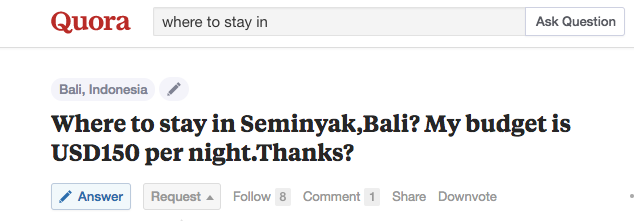
Image SEO
37. Use descriptive file names for your images
Search engines and SEO function using text and file names. Google won’t rank the images you post, but they will rank the file names that those images are labeled under. That’s why you need to label every image you upload onto your vacation rental website.
For example: if the default file is named ‘DSC0001’, the photo means nothing to search engines and won’t do anything to enhance your SEO.
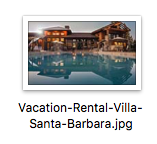
If you name that same file ‘vacation-rental-villa-santa-barbara’, it suddenly becomes searchable under any one of those keywords. Someone searching “Vacation Rental Villa in Santa Barbara” will potentially find your website thanks to the way you have optimized your image file name.
38. Add relevant alt text to all your gallery images
Alt tags or alt text are the short captions that show when you hover over an image on a website. Search engines aren’t yet intelligent enough to figure out what’s in every image, so alt text does this for them. Using keywords that relevantly describe image pictured will help your website’s images to be featured for appropriate search terms.
39. Optimize image size
Big photos = slow website loading times.
Slow websites = impatient guests.
Impatient guests = potentially lost bookings.
While it’s great to allow a closer view of the properties your guests are looking to rent, you want to make sure they get to see the photo immediately first and then give them the option of zooming in once they are interested enough to stay.
This will keep the whole page from freezing up, while still allowing them the ability to see in more detail if they choose to.
Research the optimal dimensions for your website provider and make sure you resize all photos to that uniform scale.
40. Optimize image file size
Even if the dimensions of your images are small, if you have not downsized the actual file size of the image, it might still be very slow loading the page. You want to decrease the actual file size of every image before you upload it to your website. Aim to keep your file size below 100kb whenever that is feasible.
There are many free websites like Optimizilla and Compressor for easy, accessible editing options.
41. Optimize image file type
For optimized images, you’re also going to want to make sure you’re using the best file type for the job.

We recommend using either JPEG or PNG image files. JPEG images are the most standard and basic of image files. They make it easy to provide a quality image in a small file size, and so have become very popular. You will probably use JPEGs when showcasing photos of your vacation rental properties and rooms.
Content SEO
42. Create easy-to-read content
There are many tips you can follow when you set up your vacation rental website, but the biggest piece of advice we can offer is: create informative and clear content.
Separating your website content into sections with appropriate headings is not only useful for your reader, but it’s great for SEO, too! Short, simple sentences and bullet points also help you to structure content well so it’s easy-to-read.
43. Use a tool like Grammarly to check for errors
There’s no excuse for poor grammar when fabulous free tools like Grammarly exist. Grammarly will check everything from your website content to your blog posts and social media updates.
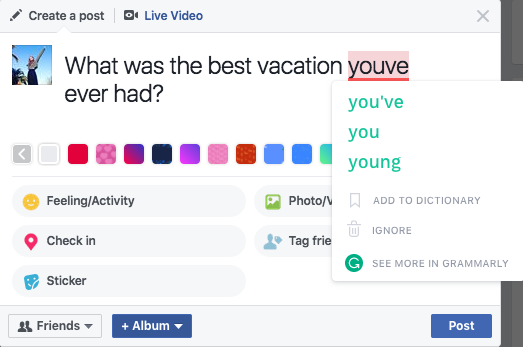
44. Use your main keyword in the page title
Whenever you sit down to write something new for your website, you’ll probably have done some keyword research to help you get started (see Keyword research section). It’s important to use your main keyword at the beginning of the post title to help you rank more quickly.
45. Use your main keyword in the body of your content
Sounds obvious, right? But often, writers forget to use the main keyword in their body text. Some research has suggested using it near the beginning of the page works better, but what’s really important is just including it somewhere naturally in the text.
46. Write longer content to rank better
Multiple studies have all shown that longer content ranks higher – with a study by Backlinko showing that in general, the average word count of a first page Google result is 1,890 words.
But remember, quality is always more important than quantity. So be wary of just “writing for the sake of it”.
47. Add internal links across your website
Internal links to other, relevant sections of your website can help lower bounce rate as you’ll keep visitors on your website longer. It’s often quite easy to do this naturally and becomes even easier if you build up a blog.
For example, if you’re writing a post about the top 10 beaches in your area, and you’ve already covered the top 10 restaurants with a sea view – there will be a really organic way you can link from one to the other!
48. Add authority external links in your pages
Mentioning relevant external sites and sources is a great way to build authority and possibly search ranking! It will also help you to develop relationships with organizations or businesses relevant to your vacation rental niche.
49. Include a call to action on every page
In case you don’t have a sticky “Book Now” button on your vacation rental website, make sure to include one clear call to action on every page!
Call to actions are absolutely essential for converting more website visitors into bookings and filling up your vacation rental calendar.
50. Generate a plan with these 101 content ideas
If you really want to take it a step further and push for amazing SEO for your website, start a vacation rental blog!
For someone who has never written a blog post before, it can be a bit daunting wondering where and how to begin.
But don’t fret!
We’ve created this guide with 101 content ideas for vacation rental blogs that are a great starting point for any new bloggers in the industry.
Split into sections such as “feature your local area”, “best of lists” and “discounts and giveaways”, you’ll be spoilt for choice on which to start writing first!
Conclusion
From optimizing images to building backlinks and writing content about your top keywords – there are so many different things you can do to improve the SEO of your vacation rental website.
Being proactive and working on your vacation rental website’s SEO from the outset will certainly help you to rank higher in the long-term. But following the 50 steps outlined in this guide is just the beginning
Due to ever-updating search engine algorithms and rules, SEO is a process that’s constantly subject to change. However, the fundamentals of what will help your website rank highly will still be valid for many years to come.
It is still important to stay informed about the latest search engine news and updates so that your website doesn’t fall behind.
We hope you’ve found these 50 actionable SEO tips for vacation rentals as useful as we did compiling them! We’re looking forward to helping you start and see great results for your website in the coming weeks and months.